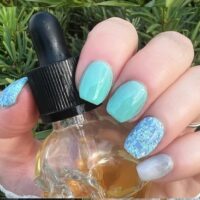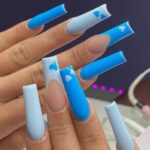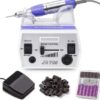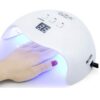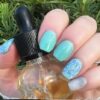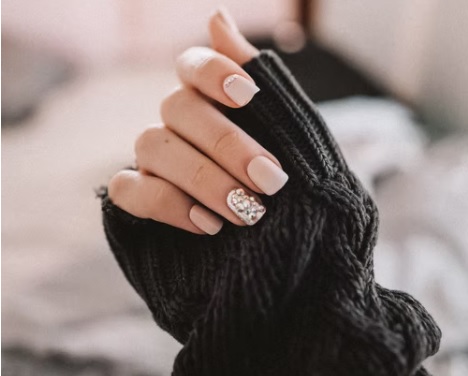
A hard gel overlay is a type of nail enhancement that uses a thicker, more durable gel formula to create a stronger foundation for your nails. The gel is applied over your natural nails and then cured under a UV or LED light. This helps to create a harder, more resilient surface that is less likely to chip or break than traditional nail polish. In addition, hard gel overlays can be used to create a variety of different looks, from natural-looking nails to longer, more glamorous styles. You can either have a hard gel manicure in nail salons or get yourself a hard gel overlay kit.
- Cost of hard gel overlay
- Is gel overlay the same as hard gel?
- What is the difference between soft gel and hard gel?
- Hard gel overlay vs builder gel
- Is Hard gel better than acrylic?
- Hard gel vs dip nails
- Hard gel overlay vs gel polish
- Hard Gel Overlay On Natural Nails
- Can you layer hard gel?
- How long does hard gel overlay last?
- Does hard gel overlay damage nails?
- Is hard gel bad for your nails?
- How to do hard gel nails?
- How to remove hard gel nails?
Cost Of Hard Gel Overlay
The cost of a hard gel overlay varies depending on the type of gel used, the complexity of the design, and the experience level of the technician. Generally, a basic gel overlay starts at around $30, while a more complex design can cost upwards of $100. However, it is important to note that hard gel overlays are typically more durable than other types of nail treatments, so they may last longer in between visits to the salon. As a result, the overall cost of maintaining a hard gel overlay may be less than other types of nail treatments.
Is gel overlay the same as hard gel?
There are many different types of nail enhancements on the market today, and it can be confusing to keep them all straight. Two common types of enhancements are gel overlays and hard gels. Both of these products can create a strong, durable finish, but they are made from different materials and are applied in different ways.
Gel overlays are made from a resin that is cured under ultraviolet light. Hard gels, on the other hand, are made from a mixture of acrylics and photoinitiators that is cured with ultraviolet light. Gel overlays are usually thinner than hard gels, and they can be more difficult to remove.
Hard gels are often used to build up the nails or to create sculpted designs, while gel overlays are more commonly used as a thinner alternative to regular polish. So, while gel overlays and hard gels may both be used to create beautiful nails, they are not the same product.
What is the difference between soft gel and hard gel?
There are two main types of gel nail polish: soft gel and hard gel.
Soft gel is a newer product on the market and is made from a combination of polymer and monomer. It is then cured using ultraviolet light.
Hard gel, on the other hand, is made entirely from polymer. It is thicker than soft gel and requires a LED or UV light for curing. Hard gel is more durable than soft gel and is less likely to chip or crack.
However, it can be more difficult to remove. When deciding which type of gel nail polish to use, consider your needs and preferences. If you are looking for a durable product that will last for weeks, hard gel may be the better option. However, if you want a polish that is easy to remove, soft gel may be the better choice.
Hard Gel Overlay vs Builder Gel
When it comes to creating strong, durable nails, there are two types of gel that stand out: hard gel and builder gel. Both have their own unique benefits that make them ideal for different situations. Hard gel is a thick, viscous gel that is applied in layers. It offers excellent coverage and can be used to create a variety of shapes and sizes.
Builder gel, on the other hand, is a thinner gel that is applied in one layer. It is more flexible than hard gel, making it ideal for those who want to create natural-looking nails. When it comes to choosing between hard gel and builder gel, it really depends on what you are looking for in a nail product. If you need something that is strong and durable, then hard gel is the way to go. If you are looking for something that is more flexible and natural-looking, then builder gel is the better choice.
Is Hard gel better than acrylic?
When it comes to artificial nails, there are two main types of materials: hard gel and acrylic. Both have their pros and cons, so it really depends on your individual needs as to which one is best for you. Hard gel is a newer material that is more flexible than acrylic, making it less likely to break. It also tends to be more durable and looks more natural. However, hard gel is more expensive and takes longer to apply.
Acrylic is a more traditional material, and it is less costly and quicker to apply. However, it is not as flexible as hard gel, making it more likely to break, and it can also look less natural. Ultimately, the best choice for you depends on your budget and how long you’re willing to spend getting your nails done.
Hard Gel Overlay Vs Dip Nails
When it comes to getting your nails done, there are a lot of different options to choose from. One popular choice is between a hard gel overlay and Dip nails. So, what’s the difference? A hard gel overlay is a type of artificial nail that is made from a hard, durable gel. The gel is applied in thin layers to the natural nail, and each layer is cured (hardened) using ultraviolet light. This process results in a strong, natural-looking nail that can last for weeks. Dip nails, on the other hand, are made from a powdery substance that is dipped into a liquid monomer.
This creates a thick, sticky mixture that is then applied to the nail. The excess is then wiped away, leaving behind a coating of powder. This coat is then cured using ultraviolet light. Dip nails are generally much thicker than hard gel overlays, and they can last for several weeks before needing to be redone.
So, which option is right for you? If you’re looking for something that looks natural and lasts long, then a hard gel overlay may be the way to go. If you’re looking for something that is thick and durable, then Dip nails might be a better choice.
Hard gel overlay Vs Gel polish
Hard gel overlays are a thicker form of a gel that is applied directly to the nail bed. This type of gel helps to strengthen and protect the nails, and it can also be used to create a variety of different nail shapes.
Gel polish, on the other hand, is a thinner form of gel that is applied over regular nail polish. Gel polish provides a high-gloss finish and significant wear resistance, but it is not as durable as a hard gel. When deciding between hard gel and gel polish, it is important to consider your own needs and preferences. If you are looking for a long-lasting and durable manicure, hard gel is the way to go. However, if you prefer a manicure that is quick and easy to apply, gel polish may be a better option.
What is hard gel overlay on natural nails?
A hard gel overlay is a type of artificial nail that is applied over the natural nail. The gel is made from a polymer that is chemically bonded to the natural nail, providing a strong and durable base. It is made from a combination of acrylic and gel products. The gel is applied over the top of the natural nail, and then a layer of acrylic is applied over the gel. This type of nail is much harder and stronger than a traditional acrylic nail, and it is also much less likely to chip or break. Hard gel overlays can last for several weeks, and they can be removed with acetone.
Can you layer hard gel?
No, layering hard gel is not a good idea. While most gel manicures involve a soft, rubbery substance that can be easily removed with acetone, hard gel is a much more durable option. Unlike soft gel, which is applied in thin layers, hard gel is typically applied in thicker coats. As a result, hard gel manicures are less likely to chip or peel, and they can last up to two weeks without losing their shine. And for that reason, you cannot layer it.
However, one downside of hard gel is that it can be difficult to remove. If you’re interested in trying a hard gel manicure, be sure to ask your manicurist for advice on the best way to remove it.
How long does hard gel overlay last?
A hard gel overlay is a type of manicure that uses a special type of gel to extend the wear of your polish and protect your nails. The gel is applied over your natural nails and then cured under a UV or LED light. Hard gel overlays can last up to 3 weeks with proper care.
To prolong the life of your manicure, avoid using your hands for activities that could damage the gel, such as washing dishes or gardening. You should also avoid exposing your nails to harsh chemicals, such as nail polish removers, household cleaners, and pool or hot tub water. With proper care, a hard gel overlay can be a great way to achieve long-lasting results.
Does hard gel overlay damage nails?
One of the most popular trends in nail care is the hard gel overlay. This treatment promises to provide a durable, long-lasting finish that is resistant to chipping and cracking. However, some nail care experts have raised concerns about the safety of this treatment.
Is hard gel bad for your nails?
Proponents of hard gel argue that when applied correctly, it does not damage the nails. However, critics point to the fact that this treatment requires the use of UV light for curing, which can be damaging to the nails. In addition, hard gel must be removed with acetone, which can also dehydrate and damage the nails. As a result, it is important to weigh the pros and cons of hard gel before deciding if this treatment is right for you.
How to do hard gel nails?
Hard gel nails are a type of artificial nails that is made from a modeling gel. They are strong, durable, and resistant to chipping and breaking. Most hard gel nails are applied by professional manicurists in salons. However, with the right tools and supplies, it is possible to apply hard gel nails at home.
The most important part of doing hard gel nails is to prepare the nails properly. This includes filing the nails into the desired shape and removing any excess cuticles. Once the nails are prepped, the gel can be applied in thin layers. The first layer should be cured under a UV or LED light for two minutes. The second layer should be cured for three minutes. Once the final layer is cured, the nails will be strong and durable. Hard gel nails can last up to six weeks with proper care.
How to remove hard gel nails?
If you’re ready to say goodbye to your hard gel nails, the process is actually quite simple. First, start by trimming your nails down as much as possible. Next, use a nail file to roughen up the surface of the gel. This will help the acetone to penetrate the gel more easily. Then, soak a cotton ball in acetone and place it on each nail.
Finally, wrap your nails in foil or cellophane to seal in the acetone and allow it to work its magic. After about 30 minutes, your gel nails should be soft enough to remove. Simply peel them off, starting at the base of the nail. If any gel remains, you can use a nail file or orange stick to gently scrape it away. And that’s it! With a little patience and some elbow grease, you can say goodbye to your gel nails for good.

